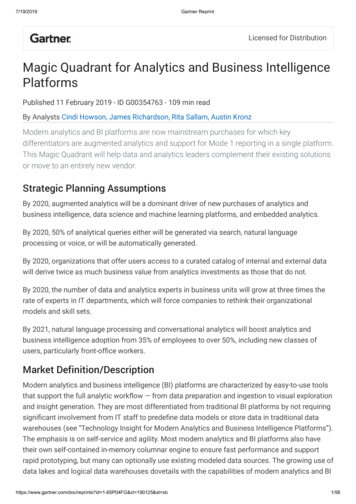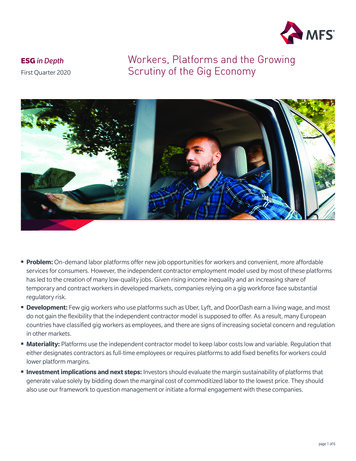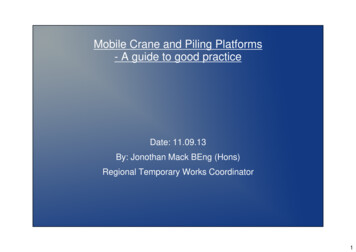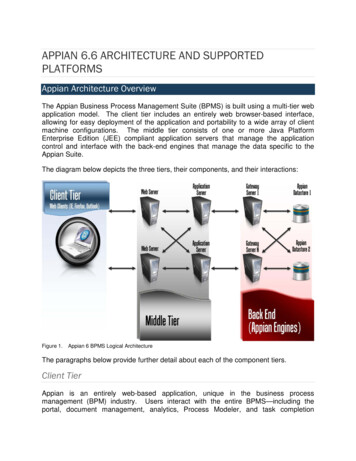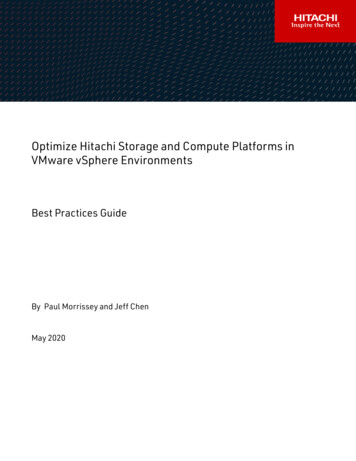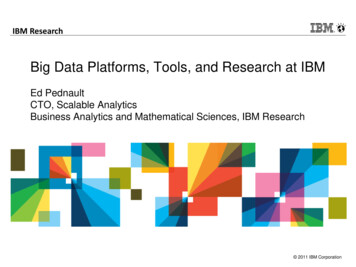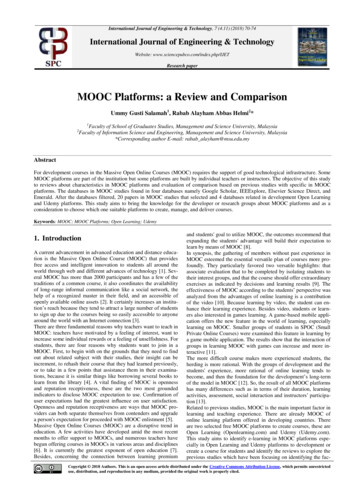
Transcription
International Journal of Engineering & Technology, 7 (4.11) (2018) 70-74International Journal of Engineering & TechnologyWebsite: www.sciencepubco.com/index.php/IJETResearch paperMOOC Platforms: a Review and ComparisonUmmy Gusti Salamah1, Rabab Alayham Abbas Helmi2*1Faculty of School of Graduates Studies, Management and Science University, MalaysiaFaculty of Information Science and Engineering, Management and Science University, Malaysia*Corresponding author E-mail: rabab alayham@msu.edu.my2AbstractFor development courses in the Massive Open Online Courses (MOOC) requires the support of good technological infrastructure. SomeMOOC platforms are part of the institution but some platforms are built by individual teachers or instructors. The objective of this studyto reviews about characteristics in MOOC platforms and evaluation of comparison based on previous studies with specific in MOOCplatforms. The databases in MOOC studies found in four databases namely Google Scholar, IEEExplore, Elsevier Science Direct, andEmerald. After the databases filtered, 20 papers in MOOC studies that selected and 4 databases related in development Open Learningand Udemy platforms. This study aims to bring the knowledge for the developer or research groups about MOOC platforms and as aconsideration to choose which one suitable platforms to create, manage, and deliver courses.Keywords: MOOC; MOOC Platforms; Open Learning; Udemy1. IntroductionA current advancement in advanced education and distance education is the Massive Open Online Course (MOOC) that providesfree access and intelligent innovation to students all around theworld through web and different advances of technology [1]. Several MOOC has more than 2000 participants and has a few of thetraditions of a common course, it also coordinates the availabilityof long-range informal communication like a social network, thehelp of a recognized master in their field, and an accessible ofopenly available online assets [2]. It certainly increases an institution‟s reach because they tend to attract a large number of studentsto sign up due to the courses being so easily accessible to anyonearound the world with an Internet connection [3].There are three fundamental reasons why teachers want to teach inMOOC: teachers have motivated by a feeling of interest, want toincrease some individual rewards or a feeling of unselfishness. Forstudents, there are four reasons why students want to join in aMOOC. First, to begin with on the grounds that they need to findout about related subject with their studies, their insight can beincrement, to rehash their course that they had learned previously,or to take in a few points that assistance them in their examinations, because it is similar things like borrowing several books tolearn from the library [4]. A vital finding of MOOC is opennessand reputation receptiveness, these are the two most groundedindicators to disclose MOOC expectation to use. Confirmation ofuser expectations had the greatest influence on user satisfaction.Openness and reputation receptiveness are ways that MOOC providers can both separate themselves from contenders and upgradea person's expectation for proceeded with MOOC enlistment [5].Massive Open Online Courses (MOOC) are a disruptive trend ineducation. A few activities have developed amid the most recentmonths to offer support to MOOCs, and numerous teachers havebegun offering courses in MOOCs in various areas and disciplines[6]. It is currently the greatest exponent of open education [7].Besides, concerning the connection between learning premiumand students' goal to utilize MOOC, the outcomes recommend thatexpanding the students' advantage will build their expectation tolearn by means of MOOC [8].In synopsis, the gathering of members without past experience inMOOC esteemed the essential versatile plan of courses more profoundly. They particularly favored two versatile highlights: thatassociate evaluation that to be completed by isolating students totheir interest groups, and that the course should offer extraordinaryexercises as indicated by decisions and learning results [9]. Theeffectiveness of MOOC according to the students‟ perspective wasanalyzed from the advantages of online learning is a contributionof the video [10]. Because learning by video, the student can enhance their learning experience. Besides video, students or learners also interested in games learning. A game-based mobile application offers the new feature in the world of learning, especiallylearning on MOOC. Smaller groups of students in SPOC (SmallPrivate Online Courses) were examined this feature in learning bya game mobile application. The results show that the interaction ofgroups in learning MOOC with games can increase and more interactive [11].The more difficult course makes more experienced students, theherding is more rational. With the groups of development and thestudents' experience, more rational of online learning tends tobecome, and then the foundation for the development‟s long-termof the model in MOOC [12]. So, the result of all MOOC platformshas many differences such as in terms of their duration, learningactivities, assessment, social interaction and instructors‟ participation [13].Related to previous studies, MOOC is the main important factor inlearning and teaching experience. There are already MOOC ofonline learning platform offered in developing countries. Thereare two selected free MOOC platforms to create courses, these areOpen Learning (Openlearning.com) and Udemy (Udemy.com).This study aims to identify e-learning in MOOC platforms especially in Open Learning and Udemy platforms to development orcreate a course for students and identify the reviews to explore theprevious studies which have been focusing on identifying the fac-Copyright 2018 Authors. This is an open access article distributed under the Creative Commons Attribution License, which permits unrestricteduse, distribution, and reproduction in any medium, provided the original work is properly cited.
International Journal of Engineering & Technology71tors about characteristics MOOC platforms, MOOCs‟ quality factors, and comparison Open Learning and Udemy platforms indifferent courses.2. Methodology3. Results and DiscussionIn this work is divided to four steps methodology (see Fig. 1)which includes: (1) Selection of databases in MOOC, (2) Reviewsof characteristics in MOOC platforms, (3) Identification of Selected MOOC platforms, (4) Comparison about development MOOCplatforms in different courses. These four steps of the methodology will be explained in the following below.Selectionof DatabasesinMOOCReviews ofCharacteristicsin MOOCPlatformsIdentification ofSelectedMOOCPlatformsComparison ofMOOCPlatformsFig. 1: Methodology2.1. Selection of Databases in MOOCThere are four databases used in research such as Google Scholar,IEEExplore, Elsevier Science Direct, and Emerald as shown inTable 1. Using these databases because related to the researchespecially related to MOOC. The English language is the languagecriteria for the databases selection and the access of the selecteddatabases from March until April 2018. Table 1 shown that theselected databases used ID, the ID is D1- D4 for describing electronic databases in categorization.IDD1D2D3D4Udemy platform. The comparison is an evaluation of two platforms in different courses and it aims to provide an overview ofOpen Learning and Udemy platforms how to develop these platforms and how these platforms work.Table 1: Databases Used in ResearchDatabasesURLGoogle //ieeexplore.ieee.org/XploreElsevier Scihttps://www.sciencedirect.com/ence DirectEmeraldhttps://www.emeraldinsight.com/2.2. Reviews of Characteristics in MOOC Platforms3.1. Database SelectionIn these databases have specific criteria. There are four categorizecriteria such as (1) Years of the related paper from 2011 – 2018,(2) Types of the databases are journaling and conference paperswith the English language, (3) Include the title and abstract, (4)Include related research in MOOC.Using these criteria, 156 papers that found from the particularcriteria and these papers also identify as related and relevant criteria for this reviews. Table 1 shows that four selected databasesused in the research included the URL. These databases analyzedsuitable and related to four criteria of our works.The keywords for databases search are (“MOOC” OR “MassiveOpen Online Courses”) AND (“Open Learning” OR “Udemy) assearch terms and keywords of the literature review. These keywords were used also for the screen the titles, abstracts, and thenfull-text reading.Figure 2 shows that there are 156 databases found by thekeywords, they are 58 databases from Google Scholar, 49databases from IEEExplore, 36 databases from Elsevier ScienceDirect, and 13 databases from Emerald. From 156 databases, wefound that 66 records excluded based on the title and matches 90papers after duplicates removed. After that, 27 based on abstractand conclusion has been removed and matches 63 papers.Excluded the records based on related studies has been removed38 papers. Finally, studies included in full-text screening found 25papers and 5 of the papers excluded in full-text screening, so theselected databases found 20 in this studies. The classification ofselected databases related to two conditions, first related toMOOC platforms (Open Learning and Udemy) and second relatedto review in MOOC studies such as development, evaluation,comparative study, implementation, analysis, experimental, andthe proposed method.Related to previous studies in MOOC, there are 11 studies reviewsabout the characteristics of e-learning, especially in MOOC. Thisreview is about how MOOC platforms can be accepted by studentsas an online learning tool. There are six characteristics of MOOCplatforms such as satisfaction, interaction, motivation, challenges,communication, and effectiveness. This review aims to giveknowledge to application developers or researchers to find outhow should the platform be built.2.3. Identification of Selected MOOC PlatformsAfter reviews about characteristics in MOOC platforms, the nextsteps are identification about MOOC platforms. According to theprevious study, there are several MOOC platforms for development or create courses. But from many platforms, two selectedplatforms are Open Learning and Udemy because Open Learningis the platform with many features and requirements such as gamification tool, forum, and also content management tool (possibleto make texts, videos, audios, and images) and then Udemy platform is the most visited and popular MOOC providers (based onAlexa Internet Global Ranking) [14, 15].2.4. Comparison of MOOC PlatformsThe last steps are evaluation in comparison of MOOC platforms.There are 4 papers related to MOOC platforms. Two papers related to Open Learning platform and two platforms related to theFig. 2: Number of Databases by KeywordsBased on the country of 20 selected papers in MOOCs studies,there are ten countries as authors‟ location and the most MOOCresearch was Spain (n 4), Malaysia, Brazil, and USA (n 3),China (n 2), and (n 1) for India, Canada, Saudi Arabia, Australia, and Taiwan (see Fig. 3).
72International Journal of Engineering & TechnologyFig. 3: The Country of Selected Papers in MOOC Studies (2011-2018)Based on the authors‟ countries, our findings there are many researchers collaborate with other countries and some researchersalso collaborate with the same country. As the detailed in years of20 selected papers in MOOCs studies significantly from 20112018 and from the research types or method, they used types ofevaluation, comparative study, analysis, development, and implementation. For the methods, some authors used mixed-method likequalitative and quantitative data such as survey, questionnaire, andstudy case are required.3.2. Characteristics of MOOC PlatformsThe Massive Open Online Courses (MOOCs) have the characteristic of bringing a new innovation [3]. The criteria of requiredMOOCs platform, it is about their characteristics such as satisfaction, interaction, motivation, challenges, communication, andeffectiveness from a student‟s perspective. The description ofcharacteristics in MOOC platforms will be evaluated in Table 2below that shows 6 characteristics of MOOC platforms.Table 2: Description of Characteristics in MOOC PlatformsReferencesCharacteristicsDescription[16, 17]SatisfactionSatisfaction is usability and abilityof use had an influence positivelyon students' satisfaction with theMOOC course. Satisfaction withthe MOOC significantly had auseful influence and positive onstudents' expectation in learningusing MOOC. Satisfaction aims tocultivate students' intention inusing MOOC [16]. Student‟ssatisfaction was “Convenience” asthe most cited reason for satisfaction. “Lack of interaction” was themost cited reason for dissatisfaction [17][18, 19]InteractionInteraction is the main goal ofstudents and teacher communication with effective, it is a challenge in MOOCs for studentsinvolved in backgrounds of learning, needs, and means [18]. Students‟ interaction with the teacheras an important factor in onlinelearning [19].[4]MotivationStudents‟ motivation was in enrollment or signing up to MOOCsbecause since they needed to findout about a specific subject or tobuild their insight, to reviews whatthey had studied previously because many students learning andparticipating in MOOCs becauseof their motivation and goals.[20, 21]ChallengesThe most challenges for the student to learning in MOOCs generated in terms of courses delivery[22]Communication[19, 23, 24]Effectivenessand quick development timeline[20]. Language has been featuredas a hindrance and the principalchallenge for many understudies[21].The potential of MOOCs is enabled to communication betweenusers. Students allowed to communicate between student andstudent as well as student toteacher to get answers to questions.The factors of learning effectiveness according to the e-learningcontext that was utilized [19].EffectivenessaccordingtoMOOCs in conventional classrooms makes positive effects onlearning results, no noteworthyevidence of negative impacts forany groups of understudies, andsatisfaction of students are lowerlevels in understudy fulfillment inblended or hybrid MOOCs inclassrooms [23]. Two factors inMOOCs‟ effectiveness are students classified in two learninggroups, learning with videos orwith exercises [24].3.3. MOOC Platforms SelectionThere are many MOOC platforms such as Open Learning, Udemy,teachable, coursera, etc. The selected MOOC Platforms to create afree course categorized into 6 platforms, they are Open Learning,CourseSites, P2PU (Peer 2 Peer University), Versal, Udemy, andEliademy [14]. This platform is the suitable one to manage andcreate a course, free platform, and easy to use by students. Fromthe six MOOC platforms, it was found two selected platforms theyare Open Learning and Udemy because many researchers usedthese platforms and these platforms identify as the best and suitable of the MOOC course needs [14].Finally, another platform in four MOOC platforms was removedfrom the selected platforms because other platforms needed .com) are selected platforms to create, manage, and deliver a course. There are differences between both platforms, for Open Learning platform, it gives tools to teachers tomake dynamic and interactive learning modules and Open Learning also gives assistance to make an interest community environment. While Udemy is designed to teach online full time or fullyhave the time and dedication, Udemy is more developed and hasbetter usability and more to choose from, and Udemy is the betteroption because this platform allows sending email announcementsto the students.Open Learning platform (https://www.openlearning.com) andUdemy platform (https://www.udemy.com) as selected MOOCplatform for delivering and managing the course. The further explanation of these two platforms for its complete descriptionsshown in Table 3.Table 3: Selected MOOC PlatformsMOOC PlatformsDescriptionsOpen LearningOpen Learning is a platform for learn(https://www.openlearning.com)ing online that delivered a course tofocus on groups or community, connectedness between students andteachers, and understudy commitment. Open Learning provides manyfeatures like a social media, thesefeatures are forums to students, theycan comment and received a commentand makes interaction while learning.
International Journal of Engineering & TechnologyUdemy(https://www.udemy.com)Open Learning has other intriguingfeatures, for example, karma pointsthat are gained through positivecomments from peers, and badgesthat can be issued either consequentlyor when a specific learning objectiveis accomplished. Open Learningprovides built-in galleries, wikis, andblog pages to highlight work andempower cooperation effort and companion criticism, while continuallykeeping up space for individuality[25].Udemy is a worldwide commercialcenter for learning and educating onthe web where understudies are acingnew aptitudes and accomplishingtheir objectives by gaining from abroad library of more than 65,000courses instructed by master educators. It was propelled in 2010 byoriginators Eren Bali, Oktay Caglaraand Gagan Biyani and has raised 16million (USD) in subsidizing fromfinancial speculators [15]. All of theMOOC courses are created independently on Udemy‟s free-to-useplatform by instructors. Udemy alsoprovides a course building MOOC forpotential instructors. It does not havean integrated learning analytics tool,but it does allow instructors to download student data for use in otheranalytic tools [26].3.4. Comparison of MOOC Platforms in DifferentCoursesTable 3 shows that the result of a search term in MOOC platforms,they are Open Learning and Udemy. The selection of this platforms (Open Learning and Udemy) because based on previousstudies, Open Learning and Udemy have their own advantages.These MOOC platforms provide to create a free course for students, so students enrolled the course with free access and theycan get more information from the course directly when they enrolled the course and the courses also can access by the studentsanywhere and every time. Udemy and Open Learning platformsprovide the ease to build free and paid courses [14]. According tocharacteristics in MOOC platforms as shown in Table 2, theseplatforms have these character in the development of the courses.Finally, both of these platforms is the suitable chosen for developing the course.Table 4 shows that the selected MOOC platforms in differentcourse according to previous works. Regarding the selection ofMOOCs platform, there are four relevant and related studies indevelopment MOOC platforms. Two studies evaluated aboutOpen Learning (https://www.openlearning.com), the two coursesanalyzed are Entrepreneurship course and Arabic Course. Andothers studies evaluated about Udemy (https://www.udemy.com)platform, the two courses are Business of Medicine and OpenSoftware Engineering.First, in Open Learning for Entrepreneurship course are provideslectures, tutorials, quizzes and several projects for the students towork in groups on a business assignment. A unique feature inEntrepreneurship course is the daily exercise in brain rewiring,which presents the forum of discussion for students with a business mindset. This platform used openlearning.com as a MOOCplatform. The MOOC especially in Open Learning is a suitableplatform to teach Entrepreneurship and another similar course andalso other courses like science and engineering [27]. In this coursehelps to highlight a few areas of conceivable noteworthy significance to students learning. For the future work, it is recommendedto another researcher also evaluate about student's satisfaction in73this
ria for this reviews. Table 1 show used in Fig. 1: Methodology 2.1. Selection of Databases in MOOC . 2.4. Comparison of MOOC Platforms The last steps are evaluation in

